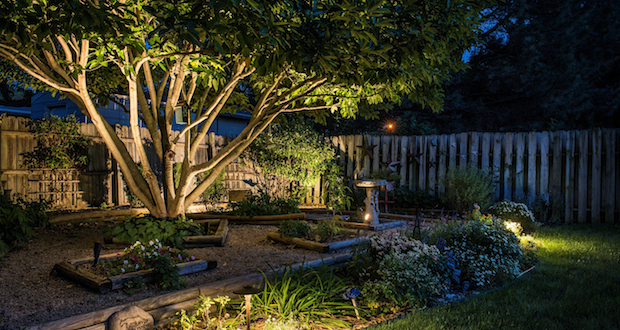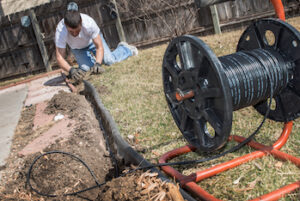Landscape lighting as an additional revenue source

Earlier this year, the American Society of Landscape Architects (ASLA) released the results of a survey that asked its members which residential landscape design elements would be most popular in 2016. Lighting, a top performer in 2015, remained among the most popular outdoor design elements for this year — along with fire pits, fireplaces and wireless Internet connectivity. In fact, more than 65 percent of the landscape architects surveyed said that they expected customers to request lighting as a part of their landscape plan.
Why has landscape lighting become so popular? More people are investing in their homes, spending a significant amount of time and money enhancing their homes’ curb appeal. When it’s done right, landscape lighting can spotlight a home’s best architectural features and draw attention to favorite plantings and trees. Lighting can also improve a home’s safety and security by illuminating formerly dark areas and making it easier to traverse stairs and outdoor paths.
“More people are taking an interest in their homes and living in them longer,” said Brian Peace, district sales manager for Vista Professional Outdoor Lighting in Simi Valley, Calif. “They want to upgrade their house rather than move to a different one. And more of the people investing in landscape lighting are living in your typical, average homes. It’s not just for people who live in higher-end homes or mansions.”
Landscaping + lighting = profits
With demand for residential landscape lighting increasing, it only makes sense that more landscape and irrigation contractors are adding it to their service menus. Statistics show that 80 to 90 percent of Peace’s customers are landscapers first and foremost who install lighting as an additional service.
“It makes perfect sense for landscape or irrigation contractors to get into the lighting business,” Peace added. “They’re already on the jobsite; they have an established clientele. It’s a relatively easy way to make more money from a single job. If you’re digging a trench to put in sprinkler pipe, you can also lay lighting wire in the ground in just a few additional seconds. It’s so simple to learn, and it doesn’t require any additional licenses. Because it’s low-voltage, it’s safe as well.”
Along with the ability to earn additional income, offering lighting also gives that contractor a more complete portfolio. If a homeowner wants a landscaping project done, including outdoor lighting, that homeowner is more likely to go with a business that can handle all of his or her needs, not just a few. At that point, not offering outdoor lighting design and installation could cause a contractor to lose a job entirely.
Getting started
Although there are some definite dos and don’ts, overall, offering landscape lighting is a relatively simple proposition. Most experienced contractors will have the basic tools they need already on hand. Plus, it doesn’t take a large crew or an investment in additional employees to offer lighting installation. Even small businesses with one- or two-person crews can easily handle lighting jobs.
“You tell a guy that he can put in a 10- to 12-light system in less than a day and make an additional $800, he’s usually going to go for it,” Peace says. “One guy can do it, two guys can do it and larger crews can do it.”
While the actual task of installation is something that can be learned, there is a certain degree of artistic flair that will make one contractor more successful than another.
“Most guys play around with lighting at their own homes first, then they seek out a couple of jobs and really get started,” said Peace. “One of my customers started out with landscape lighting about 10 years ago, and within five years, he was performing 200- to 300-fixture installations. He goes out during the day to check out the customer’s home and landscape, and then he goes back out at night to make any necessary adjustments. It’s really an art at that point.”
Peace recommends that a contractor who wants to get into landscape lighting take at least some training before actually performing jobs for customers. Peace’s company, Vista, offers numerous training programs nationwide that include basic lighting installation, estimating, troubleshooting and design assistance. Information about available training is available at Vista’s website, [ital>www.vistapro.com<ital].
“A contractor may need to invest six to 10 hours of class time to get a basic knowledge of outdoor lighting,” said Peace. “At Vista, we actually go with our students to their first few jobs to assist with the design work, getting the bid, and so on. We do recommend that individuals new to the business set aside some time to install lighting at their own homes or a friend’s home. That gives them the opportunity to play and experiment a little, see how much light an LED at 2.5 or 4.5 watts will give them, for example.”
Keys to success
When it comes to finding a lighting supplier, most contractors tend to stay local for the sake of convenience. However, the best practice is to get quotes from two to three different distributors to see who offers the best pricing. From there, determine which distributor also has the ultimate combination of product knowledge and experience.
“Back when I was installing lighting, I typically used two distributors all the time because they were convenient to my location, the price was right, and if I had a question or problem, they could help me solve it pretty quickly,” said Peace. “At first, price tends to be a contractor’s primary concern. But the distributor relationship will eventually come into play. You need to feel that the person with whom you’re working is knowledgeable about what they’re selling and can help you work through a problem when necessary.”
Knowledge is also a key factor when it comes to a contractor’s ultimate failure or success at the landscape lighting business. If contractors don’t know how to sell lighting and are uninformed about the products available, they can’t speak to their businesses intelligently. Also, prospective clients may get scared off because they know more about landscape lighting than the contractor they’re trying to hire.
“People today can go to the Internet and find out nearly everything they need to know about a product or service,” said Peace. “Outdoor lighting is no different. Many homeowners will self-educate first, and then they call contractors for bids. I’ve had contractors tell me, ‘I didn’t get the bid, but the clients sure knew a whole lot about lighting.’ I respond, ‘Would you hire someone for a job who doesn’t know as much as you do?’
“Landscape lighting can be very profitable if they get into it and do it right. Get educated and then experiment with it. It can be an easy money-maker.”
Article provided by Vista Professional Outdoor Lighting. For more information, visit www.vistapro.com.



